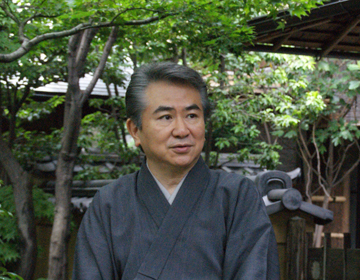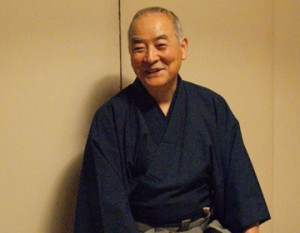The Meaning Behind Sensu
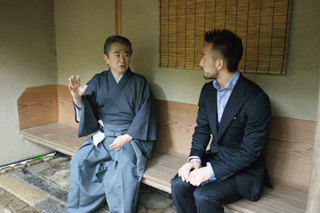
We entered the gate and were invited into a room called the “yoritsuki”. Our host is the 13th Iemoto of Enshu School of Tea. Of course, under normal circumstances we would not have the Iemoto himself greet us at the front gate, especially as he is the host. But on this visit, since we were there to learn about the Enshu School, he made the gesture of meeting us from the start. First, we enter the ”yoritsuki”, where normally people prepare for the tea ceremony. For our visit, the Iemoto himself offered Nakata a ”sensu” and ”fukusa” to use. As Nakata received the 2 items, he noticed that the ”sensu” was quite small.
“This is unusually small. Is there a meaning behind this?”
“”Sensu” used for tea ceremonies are used to greet people, not to fan yourself. You sit properly with your legs folded and place it on your lap when you first greet your guest. It shows respect, acting as a sort of boundary to keep some tension. Therefore it is better to use a small sized ”sensu”. You do at times use it as a fan to fan the palm of your hand to cool it slightly, never would you use it with big movements to fan your face or your body. “
Fully taking in the “roji”
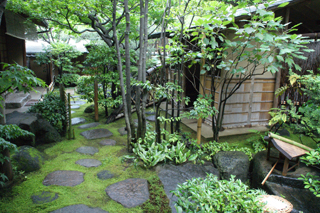
After staying a while in the ”yoritsuki” we step outside. Before entering the tea room, we walk through a small alley, the ”roji”. In a formal setting, the host would appear here, and greet his guests. ”Roji” is like an inner garden. While walking in this garden Nakata commented, ”What a nice calm atmosphere.”
Enshu School of Tea is a school that was started by Kobori Enshu. Kobori Enshu, a feudal lord of the Edo period, was also active as an architect and a landscape architect. He played an active role in the restoration of the Bicchu Matsuyama castle, the renovation of the Sunpu Castle and the construction of the Nagoya Castle tower and the Goyozeiin Imperial palace.
For a long time in the history of Japan, gardens played an important role and were appreciated for viewing. Eventually, gardens which were meant to walk through emerged. Enshu was said to have made gardens for different purposes.
“Gardens for tea ceremony are designed for the guests to enjoy,” Sojitsu explains. Enshu used to create his gardens and structures by imagining the visitors and users. He never made his works of art to express himself.
Space to Appreciate Tea
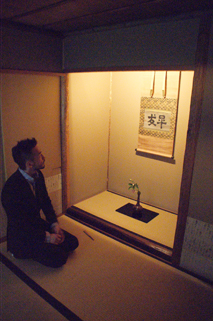
After fully appreciating the roji garden, we enter the tea room. We duck through a small door called the ”nijiriguchi”.
And the door is closed behind us. It is closed with a rather loud bang. This is “to announce that the last guest has entered.” As soon as we enter the tea room, the ”kakejiku” hanging in the ”tokonoma” and the flowers in the vase capture our attention. In Tokyo, we had opportunities to meet many ikebana masters. The flower in the tea room is quite different from ”ikebana” flowers. Nakata asked about this. “The flowers for ”ikebana” and the flowers used for tea ceremony are quite different. Their objectives are different. The flowers here need to be inconspicuous, as they are not the main character. They cannot interfere with the tea, so strong scented flowers are never used. It cannot interfere with the calligraphy either. It cannot distract the guests while they enjoy the tea. The flowers have a different meaning, and they are there to support the overall ambience.” The flowers help create a good sense of space in the tea room.
Everything is for the Tea
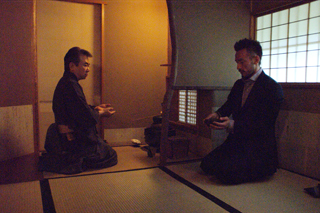
We drank the tea prepared by Sojitsu . Since we were not familiar with manners associated with tea, we need to be instructed step by step, and Sojitsu showed us, helping to alleviate our anxiety.
At the end, we asked to see the ”chashaku”. This particular ”chashaku” was created by Sojitsu using bamboo from Myanmar, where he visited to perform a tea ceremony.
“I made this chashaku as a “bridge” between Japan and Myanmar and named it for the Japanese word for bridge, “kakehashi”. I used it for this tea ceremony so I could convey my wish for you to continue your travels and act as a “kakehashi” or bridge ,” he said, giving us encouragement.
From the ”yoritsuki”, ”roji”, the tea room, the flowers, calligraphy, and the tea and its cup. All of these items are part of what it means to enjoy “tea”, and we were able to experience this first hand.



